This article needs additional citations for verification .(December 2014) |
| EU06 | |||||||||||||||||||||||||||||||||
|---|---|---|---|---|---|---|---|---|---|---|---|---|---|---|---|---|---|---|---|---|---|---|---|---|---|---|---|---|---|---|---|---|---|
 | |||||||||||||||||||||||||||||||||
| |||||||||||||||||||||||||||||||||
| |||||||||||||||||||||||||||||||||
| |||||||||||||||||||||||||||||||||
| |||||||||||||||||||||||||||||||||
EU06 (also manufactured as AEI E) is a class of electric locomotives in service with the Polish state railway PKP.
This article needs additional citations for verification .(December 2014) |
| EU06 | |||||||||||||||||||||||||||||||||
|---|---|---|---|---|---|---|---|---|---|---|---|---|---|---|---|---|---|---|---|---|---|---|---|---|---|---|---|---|---|---|---|---|---|
 | |||||||||||||||||||||||||||||||||
| |||||||||||||||||||||||||||||||||
| |||||||||||||||||||||||||||||||||
| |||||||||||||||||||||||||||||||||
| |||||||||||||||||||||||||||||||||
EU06 (also manufactured as AEI E) is a class of electric locomotives in service with the Polish state railway PKP.
EU06 has driving cabs at both ends. The locomotives are equipped for multiple working which allows one driver to drive two coupled engines from one cab. One locomotive can haul passenger trains of up to 650 tonnes (640 long tons ; 720 short tons ) at 125 kilometres per hour (78 mph) and freight trains of up to 2,000 tonnes (2,000 long tons; 2,200 short tons) at a speed of 70 kilometres per hour (43 mph).[ citation needed ] Two locomotives coupled in multiple can haul a freight train of up to 3,600 tonnes (3,500 long tons; 4,000 short tons).[ citation needed ] These figures apply to driving on level gradients.
All members and panels are made of Cor-Ten steel and the underframe is a shallow, cellular structure with closely spaced light-gauge longitudinal and transverse members plated above and below to make a set of closed cells. [2]
The body sides are built up on rectangular vertical tubes forming a set of pillars and are double-skinned for additional strength and rigidity. [2] This maintains the shape of the locomotive allowing the roof of the entire machine space between the two cabs to be removed to allow machinery to be lifted out and replaced. [2] The superstructure is built to withstand buffing loads up to 295 long tons (300 t; 330 short tons). [2] English Electric made extensive use of aluminium alloys and GRP for panelling, doors and ducts. [2]
Current collection is by single-pan air operated pantographs, which feed the main power circuits by a high-speed circuit breaker. [2] The main resistances were made by Metropolitan-Vickers' parent company, Associated Electrical Industries. [2] The four traction motors are permanently connected in series pairs, with series-parallel combinations between pairs. [2] Parallel and 12 field weakening positions give a total of 55 running notches. [2] The four traction motors have Alstom quill drives. [2]
The minimum curve radius that the locomotives can negotiate is 6 chains (396 ft; 121 m): any curve tighter than this could cause severe flange wear on the wheels. [2] In order to reduce flange forces, the bogies are linked by a tubular-framed spring-loaded inter-coupling and flange lubricators are fitted to each wheel. [2]
In 1936–1938 the Contractors' Committee, a joint venture of Metropolitan-Vickers and English Electric, had supplied six 1,200 brake horsepower (890 kW) electric locomotives and 80 three-car electric multiple units for the electrification of Warsaw suburban services. [1] British Insulated Cables supplied the overhead line equipment. [1] In 1945 British Insulated merged with a competitor to become British Insulated Callender's Cables, and in 1949 Metropolitan-Vickers, English Electric and BICC contracts to replace locomotives, EMUs and equipment damaged in the Second World War. [1]
In the early 1950s PKP urgently wanted mixed-traffic electric locomotives for the rapid electrification of Poland's railways. ET21 freight locomotives were already in production but there was a lack of passenger locomotives. The plan was to buy several items of foreign-built locomotives and a license and start domestic production afterwards.
In 1956 talks with companies from Austria and Switzerland started, but were broken off soon after.[ citation needed ] In June 1959 Poland awarded a new contract to for overhead electrification and 20 locomotives to the Contractors' Committee, which now included BICC as well as AEI Traction and English Electric. [1] The contract included a licence agreement for Poland to manufacture 2,000 tons of copper contact wire, enough to electrify 1,450 miles (2,330 kilometres) of railway. [1]
Not all electric devices were included in the licence agreement.[ citation needed ] EU06 locomotives are roughly similar to the British Rail Class 83 mechanically, which were built by English Electric at Vulcan Foundry, Newton-le-Willows in the UK, in the same period; electrically the layout and equipment was similar to classes 5E/5E1/6E/6E1 operating on South African Railways.
The first EU06 locomotive was delivered to Poland in early 1962 and after series of trials it was assigned to Kraków Prokocim depot.[ citation needed ] Seven locomotives had been delivered by the end of April 1962 [1] and 19 by the end of the year.[ citation needed ] Delivery of the last locomotive was delayed until 1965 by failures of the armature. The locomotives were operated on all lines serviced by Kraków Prokocim depot.
Class EU06 was an innovative design that became a milestone in Polish motive power construction. Along with the EU07, a similar locomotive class built in Poland under licence by Pafawag in Wrocław and Cegielski in Poznań, almost 500 locomotives were built. EU07 locomotives were also the basis of the duplex freight locomotives of PKP class ET41. Several construction innovations from class EU06 were introduced into later classes such as EP08, ET22 and EP09.
The last EU06 unit traveled from Žylina to Katowice on March 31, 2009. In the middle of December 2010, 7 out of the 14 remaining locomotives were scrapped at Kraków Prokocim Cargo Station; those 7 locomotives were: EU06-02, EU06-04, EU06-05, EU06-08, EU06-11, EU06-14 and EU06-16. The first locomotive of the class (EU06-01) ended its service in 2004, due to its technical performance certificate expiring. Remaining extant locomotives worked for PKP Cargo until 2012, and were afterwards kept in long-term storage in poor condition. In 2012, EU06-01 became an active monument in Chabówka Railway Heritage Park.
English Electric delivered the EU06 class in a two-tone green, with a broad dark green waistband on a pale green body. [1]
In recognition of the locomotives being built in the UK, it was hoped that one example of the class would be repainted in British Rail Electric Blue livery, complete with BR Lion and Wheel insignia. Instead, an EU07/EP07 –EP07-1051 [3] –was painted in the livery in February 2008.

The M62 is a Soviet-built diesel locomotive for heavy freight trains, exported to many Eastern Bloc countries as well as to Cuba, North Korea and Mongolia. Beside the single locomotive M62 also twin versions 2M62 and three-section versions 3M62 have been built. A total number of 7,164 single sections have been produced, which have been used to build 5,231 single-, twin- and three-section locomotives.

SU46 is the name for a diesel universal purpose locomotive working for Polish PKP. Cegielski has produced 52 machines in years 1974-1977 and 2 modified in 1985.

SP45 is the name for a Polish diesel locomotive. It was built for the purpose of passenger traffic. No operating examples of this loco remain. All have been phased out or rebuilt into SU45.
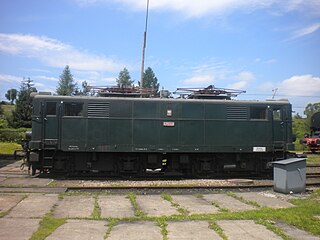
The PKP class EP03 is a type of electric locomotive used by Polish railway operator Polskie Koleje Państwowe (PKP).

EU07 is the name for a Polish electric locomotive in service of the Polish railway operator PKP. This locomotive was designed as a mixed traffic locomotive, and as such is used both in freight and passenger traffic.
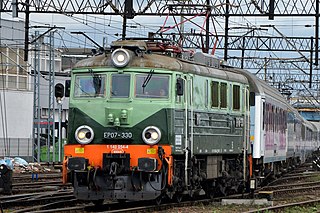
PKP class EP07 is a class of standard-gauge electric locomotives used primarily for passenger trains in Poland. They are rebuilt EU07 class locomotives, which in turn are the direct successors to the post-war British EU06 series locomotives. The only operators of this locomotive series are PKP Intercity and Polregio.

EP08 is the name for a Polish electric locomotive used by the Polish railway operator Polskie Koleje Państwowe (PKP), produced between 1972 and 1976 in Pafawag, Wrocław. The construction is based on the EU07 locomotive.
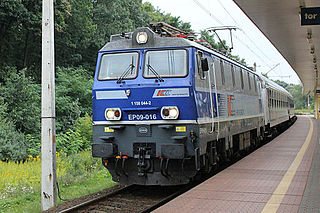
EP09 is a Polish electric locomotive used by the Polish railways, Polskie Koleje Państwowe (PKP) and produced by Pafawag of Wrocław between 1986 and 1997.

ET21 is a name for a Polish electric freight locomotive produced between years 1957 to 1971 in Pafawag. It was the first post-war Polish electric locomotive, designed in 1955. Besides being delivered for PKP, ET21 locomotives were delivered to the mining industry, where they are used up to now.
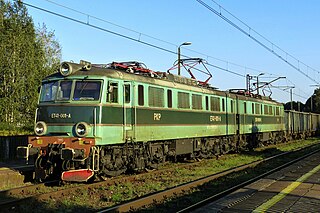
ET41 is the name for a Polish electric locomotive used by the Polish railway operator (PKP). Three such locomotives were briefly rented to the Croatian Railways between 1995 and 1996 and were given the designation HŽ series 1081 there.
The history of rail transport in Poland dates back to the first half of the 19th century when railways were built under Prussian, Russian, and Austrian rule. Of course, "divided Poland" in the 19th century was the territory of the former Polish–Lithuanian Commonwealth and not that one of today's Republic of Poland. After Polish independence was declared on 11 November 1918, the independent Polish state administered its own railways until control was surrendered to German and Soviet occupiers during World War II.

Steeplecab is railroad terminology for a style or design of electric locomotive; the term is rarely if ever used for other forms of power. The name originated in North America and has been used in Britain as well.

The Indian locomotive class WAG-9 is a class of 25 kV AC electric locomotives that was developed in 1995 by ABB for Indian Railways. The model name stands for broad gauge (W), AC Current (A), Goods traffic (G), 9th generation (9) locomotive. They entered service in 1996. A total of 4650 WAG-9 have been built at Chittaranjan Locomotive Works (CLW), with more units being built at Banaras Locomotive Works (BLW), Bharat Heavy Electricals Limited (BHEL) and Patiala Locomotive Works (PLW). It was the most powerful freight locomotive of its fleet until the formal introduction of the WAG-12.

The Soviet-made ET42 is PKP's most powerful standard gauge electric freight locomotive. Due to its provenance, it is often referred to by its nickname of Rusek or Czapajew (Chapayev).
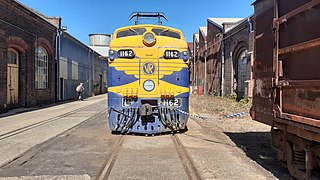
The Victorian Railways L class was a class of electric locomotives built by English Electric and operated by the Victorian Railways and later V/Line from 1953 until 1987 primarily on the Gippsland line. They were the only class of main line electric locomotive operated in Victoria.

PKP classes Ty2 and Ty42 is a class of freight (T) 2-10-0 (y) steam locomotive used by Polskie Koleje Państwowe from 1942 (42) onwards. They are Deutsche Reichsbahn class 52 Kriegslokomotiven, either acquired new (Ty42), or secondhand (Ty2), having been built during World War II in factories in many European countries in 1942–1945.
Aurizon electric locomotives are used by Australian rail operator Aurizon in Queensland.

Baldwin, the locomotive manufacturer, and Westinghouse, the promoter of AC electrification, joined forces in 1895 to develop AC railway electrification. Soon after the turn of the century, they marketed a single-phase high-voltage system to railroads. From 1904 to 1905 they supplied locomotives carrying a joint builder's plate to a number of American railroads, particularly for the New Haven line from New York to New Haven, and other New Haven lines. Westinghouse would produce the motors, controls, and other electrical gear, while Baldwin would produce the running gear, frame, body, and perform final assembly.

The Transnet Freight Rail Class 20E of 2013 is a South African electric locomotive.

Railway electrification in Poland is the process aimed at increasing the efficiency of railways and improving the railway services offered by supplying Polish railways with electricity and implementing electric rolling stock, which replaces rolling stock with other drives, mainly conventional diesel traction. By the end of the 1970s, thanks to massive electrification and the introduction of a large amount of electric rolling stock into service, it allowed to replace a large number of steam locomotives and older diesel rolling stock. Despite the abandonment of works in the 90s, currently PKP and other entities managing the railway infrastructure, such as PKM or DSDiK, are working on the implementation or are already implementing the electrification of their lines. Currently, the electrification of railways in Poland is aimed at improving rail transport by increasing competitiveness and attractiveness and replacing diesel traction of national importance and saving fuel on regional lines and railways mains such as line 31 from Siedlce to Siemianówka, line 137 from Kędzierzyn-Koźle to Legnica and line 203 from Tczew to Kostrzyn.